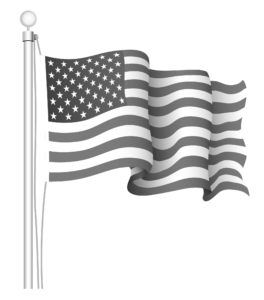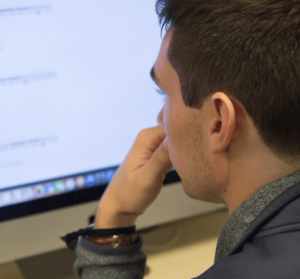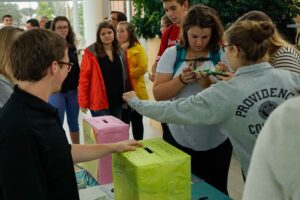Tag: Brian Garvey ’20
Let’s Talk About …Net
by The Cowl Editor on January 18, 2018
National and Global News
An Analysis On Net Neutrality and What it Means For You
By Brian Garvey ’20
News Staff
 On Sunday December 14, 2017, the Federal Communications Commission (FCC) voted 3-2 to repeal net neutrality. Net neutrality is the idea that all data on the internet is same and equal, and therefore no internet service providers, such as Comcast or Verizon, may charge by user, content, website, platform, application, type of attached equipment, or method of communication. Net neutrality was established in 2015 under the Obama administration, and has been vehemently opposed by the massive internet companies within the U.S.
On Sunday December 14, 2017, the Federal Communications Commission (FCC) voted 3-2 to repeal net neutrality. Net neutrality is the idea that all data on the internet is same and equal, and therefore no internet service providers, such as Comcast or Verizon, may charge by user, content, website, platform, application, type of attached equipment, or method of communication. Net neutrality was established in 2015 under the Obama administration, and has been vehemently opposed by the massive internet companies within the U.S.
The leading force for the repeal of net neutrality was Republican Ajit Pai, the current chairman of the FCC. Appointed to the FCC board by President Barack Obama in 2014, Pai became the first Indian American to become the chairman when President Donald Trump designated him to the position. A University of Chicago Law graduate and former lawyer for Verizon, Ajit Pai has always been very outspoken against net neutrality, and has been strident in stating his belief in the benefits of the repeal of net neutrality.
General reaction and public opinion about the repeal has been very negative, with social media exploding against the dismantling of net neutrality. One of the most contentious aspects of the repeal of Net Neutrality is what is actually going to happen; no one seems to be sure of what will happen until it actually happens.
There are four scenarios that have been deemed possible:
The first, and most unfavorable, scenario is that service companies will be able to control every aspect of the internet. Competing company sites will be blocked, and consumers will not be able to access services, such as Netflix or Facebook, that use a different service provider.
Yet many experts say that in this scenario, the market and competition would keep the internet essentially the same, as an internet service policy with significantly fewer regulations would outperform the strictly regulated company, thus forcing the regulated company to change their policies.
The second, and most positive, scenario, is that consumers will actually have a lower internet bill and higher internet speed. Because of the repeal, internet companies will also be able charge companies that, under net neutrality, were able to use massive amounts of data for free. This would directly affect Netflix, and is the reason why Netflix has been so outspoken against the repeal.
Because companies who use large amounts of data will be charged more for their usage, the service companies will look for opportunities to increase their income. The additional income can be used to improve the network and infrastructure which therefore would increase the speed of the internet while simultaneously lowering the consumer’s bill.
But this relies on these internet companies lowering the bill on their own, and that is by no means a foregone conclusion.
Furthermore, a company like Netflix might increase their prices due to the fact that they will pay more for internet access.
The third scenario is that web services are like tiered packages. If a consumer wants to access services like Netflix, they have to pay for the package, similar to HBO. Essentially, it will increase the price of services consumers previously had access to.
The final scenario, and seemingly most likely, is that nothing will really change. The idea is that companies will not provide fastlanes for paying companies and restrict web services out of fear of consumer backlash, as well as the distinct possibility of the rules changing; Net Neutrality was only in place for two years, and Ajit Pai has been shown just how quickly the rules can be changed.
Essentially, there is a broad range of scenarios, ranging from complete restriction to unlimited data for lower prices, but the general consensus from educated experts is that the actual outcome will be somewhere in the middle; whether that will be worse or better than the internet during net neutrality cannot be determined until the actual changes become apparent.
Class Registration Update
by The Cowl Editor on December 7, 2017
Campus
Changes on Cyberfriar Make Registration Easier and Simpler for Students
by Brian Garvey ’19
News Staff

The new registration system recently put in place by Providence College was met with resounding approval from students across campus. Many students found the new Schedule Planner to be incredibly easy to operate, as well as much simpler to work with. Peter Palumbo, director of academic advising, said, “Students by and large loved it. They really appreciated how easy it was, and how simple it was to navigate.” Many students felt that this new system was much needed, as the old registration process was outdated and inconvenient. Ryan Gallahue ’20 said, “I really, really liked the system. The old Cyberfriar way of having to look up all these different classes and only be able to see one at a time was very frustrating. The Schedule Planner really helped me physically see what my schedule would look like, and I was able to plan much better than I had before.”
Even seniors, who are used to the old system, felt that the new system was a substantial improvement. Gina DeBernardo, assistant dean of enrollment services, said, “We were at 95 percent buy-in from the whole campus. Some of my senior workers in the office here were saying they weren’t going to use it and that it was new and they wouldn’t understand it, but they all loved it too.” Kevin Gillooly ’18 said, “I really, really wish I had this all four year. It made my life so much easier. I really liked being able to see all the different combinations of classes I could do instead of having to physically draw up five or six schedules.”
Students were not the only ones who enjoyed the new updates. In fact, many department chairs and advisors were grateful for this new system, as it helped them to better assist their students in planning their schedules. DeBernardo said, “I received emails from different department chairs and advisors saying thank you for the new system, because it helped students build schedules as they could log in and see how students were building their schedules”.
One of the few complaints from students was that it was somewhat difficult at first to figure out how to use some of the program’s more complicated features, such as the Registration Cart and the Waitlist. This was partly due to the new system; even the faculty in charge were not one hundred percent sure how each feature would act under the pressure of a thousand students using it at the same time.
DeBernardo said that, “These are all questions we didn’t know the answer to until we saw it live. We can test it until we’re blue in the face, but it is hard to know what it looks like on registration day. Now that we have lived through it, we know how the system reacts.” To help better educate students, advisors will receive coaching sessions to better answer their questions about the system for next semester. Peter Palumbo said that, “We are looking to have multiple training sessions next semester, hopefully at least once a month, to refresh them on best practices, update them on changes we’ve done, and anything to help improve the experience of both students and faculty.”
Not much is going to change with the program for registration next semester, due to the fact that it was so successful. The Waitlist program will still be limited in its availability, as DeBernardo stated, “There’s still a couple issues with this program, and we want to make sure it is flawless before we open it up to all campus. In the next semester, we are looking to send out an FAQ about all the ins-and-outs of the program to help students better understand it.”
Palumbo is also working with Student Congress to set up a freshman registration orientation, so that students not even used to the old program will be able to get a handle on de-stressing their registration. Clearly satisfied about how the program exceeded expectations, both Palumbo and DeBernardo hope that this program can continue to excel and make life easier for students of Providence College
Office of Student Activities Hosts Dollar Day
by The Cowl Editor on November 16, 2017
News
by Brian Garvey ’20
News Staff

Thanksgiving is often thought of as a time for family, food, and football. Yet, as we focus on giving thanks for our own good fortune, we forget to focus on those who are less fortunate. Not everyone can afford turkey, stuffing, and all the fabulous foods we have.
In an effort to focus on giving back while also giving thanks, the Smith Hill Community Development Corporation partnered with Providence College to introduce Dollar Day on Wednesday, Nov 8. The Smith Hill CDC provides up to 200 families with Thanksgiving dinners each year.
Dollar Day allows students to donate to the cause of providing quality Thanksgiving dinners to families living in poverty from the Smith Hill community. In an effort to make donation easier for students, donations were accepted in the form of cash or Venmo.
Dollar Day gets its name from its promotion; “If each undergraduate student donates at least one dollar, we can raise over $4,000 that can ensure more families are able to enjoy a warm Thanksgiving dinner!” Marlena Forrester ’18, a member of Student Congress, said, “We were able to get $445.47 from Wednesday alone and we were hoping to get this number up to $500 by the end of the week!”
Along with Dollar Day, the Office of Student Activities and Cultural Programming collaborated with other clubs to raise money to purchase canned and boxed goods for the Annual Thanksgiving Drive.
Forrester said, “This year we have gotten 40 turkeys donated by Sodexo, which is thanks to students participating in a mini-basketball game to potentially get a turkey donated.” Many students really enjoyed the message of giving thanks by giving back. Joe McDonald ’20 said, “I really like the idea of helping others. I love Thanksgiving, and the thought of families not being able to enjoy the happiness that it can bring is really sad. I’m glad I can help make a difference in people’s lives.”
For those who want to get involved in further donation, the Smith Hill CDC is holding a Turkey Drive on Nov. 18 from 10 a.m. to 2 p.m. at 231 Douglas Avenue.
National News: Tragedy in Texas
by The Cowl Editor on November 9, 2017
National and Global News
by Brian Garvey ’20
News Staff
 On Sunday, November 5, a terrible tragedy struck Sutherland Springs, Texas. Devin Patrick Kelley opened fire with a Ruger AR-556 assault-type rifle on those attending Sunday at First Baptist Church, killing 26 people. The victims ranged from 18 months old to 77 years old.
On Sunday, November 5, a terrible tragedy struck Sutherland Springs, Texas. Devin Patrick Kelley opened fire with a Ruger AR-556 assault-type rifle on those attending Sunday at First Baptist Church, killing 26 people. The victims ranged from 18 months old to 77 years old.
After going back to his car to reload, a neighbor of the church, Stephen Willeford, began firing at him with his rifle, hitting him in both legs. Kelley proceeded to try to flee in his car, pursued by Willeford and another passerby responding to the shots. After chasing Kelley into the next county, Kelley swerved and crashed in a ditch on the side of the road, having shot himself in the head. Willeford insisted later, “I think my God, my Lord protected me and gave me the skills to do what needed to be done.”
A deeply disturbed man, 26-year-old Kelley was dishonorably discharged from the U.S. Air Force in 2012 for fracturing his infant son’s skull and attempting to choke his wife. His conviction of a crime of domestic violence is potentially punishable by a prison sentence of more than one year, and therefore Kelley should have been banned from buying or possessing a firearm for at least a year, according to Retired Colonel Don Christensen, the Air Force‘s top prosecutor during this charge.
Yet despite this ban—and despite the fact that he did not possess a license to carry—the Federal Bureau of Alcohol, Tobacco, Firearms, and Explosives reported that Kelley purchased four guns in the four years after his conviction and discharge. Authorities have indicated that this tragedy was motivated by Kelley’s family issues, as he had sent threatening texts to his mother-in-law, who was a member of the Church.
This possession of firearms has reignited the gun control debate in America, as many people are calling for a higher regulation of gun purchases, strict background checks, and the outright outlawing of assault weapons. In response to recent tragedies, Massachusetts banned bump-stocks, an accessory that enables an increased rate of fire.
This tragedy is compounded by the fact that this was an incredibly tightknit town, with the church being a central part of Sutherland Springs‘ identity. Yet one common theme when Texans talk about this horrible shooting is that the Texas community bond is too strong to be broken by this evil man.
Chase Rasch ‘18, who grew up in Dallas, about four hours north of Sutherland Springs, said that, “I take significant pride in being a ‘Texan.’ It is incredibly hard to hear about such a tragedy happen so close to home, and my heart goes out to the families that are suffering right now. That being said, the Texas bond is strong, and I am confident that we will unite around this act of terror and come out on top as a community.”
Caroline Mallon ’20, who is from Houston, echoed, “Texas has had a really hard couple of months due to the destruction caused by Hurricane Harvey. Many people have lost their homes, people have died or been injured, and this is the last thing I think anyone would have expected to happen. If there’s one thing I have learned since moving to Texas, it’s that Texans stick together; people will move mountains to help each other, even from hundreds of miles away. I can only hope and pray that the people of Sutherland Springs will find strength in one another.”
For those who want to help the people of Sutherland Springs, South Texas Blood and Tissue Center is urging anyone with O-positive or O-negative blood type to make a donation. People can also donate directly to the families through the First Baptist Church website.
New Class Registration Tool Developed to Assist Students
by The Cowl Editor on October 26, 2017
Campus

By Brian Garvey ’20
News Staff
Registering for classes at Providence College is no walk in the park. The stress that comes from the prospect of not getting into the right classes will affect even the most reasonable of students. Now, Enrollment Services is trying to make student’s lives easier through three different objectives; DWC pre-registration, automated waitlists for business majors, and a revamped class selection.
The first initiative, DWC pre-registration, is meant to give students have more control over their schedule. Originally, only Sophomores registering for Colloquium could pre-register in this manner. Assistant Dean Gene DeBernardo, one of the driving forces behind these new changes, said, “we got a lot of feedback from student congress that students want to take ownership of the schedule. It will allow you to work with the courses that you need to work with and build your schedule according”.
The second initiative is mainly meant for business majors, as the waitlists will only be applied to majors specifically in the business school. Students who are unable to get into high-demand classes will be able to put themselves on waitlists for these classes.
If a spot opens up, then the highest student on the waitlist will have the seat reserved for 24 hours, during which time they will have to register for the class. If they miss their chance, or another spot opens up, the next highest student will have the seat reserved.
Peter Palumbo, the director of academic services, said, “It helps students think big picture, as some students feel like they don’t have an option once they get closed out of a class.” The waitlist allows students to gain more control and take ownership of their schedules, instead of just saying “now what?” According to Palumbo, it allows students to have more options, instead of feeling forced to register for a class they don’t want or need.
This first semester of registration will be a test run for the waitlists, and if it performs the way it is expected to it will be applied to all classes for registration in the fall. Tom McMahon ’20 said, “I like the idea of the new waitlist, because it was a huge hassle to put myself on a waitlist last year. Now that it’s easier, it takes away from some of the stress of registering which is awesome.”
The third and largest initiative is the schedule planner. This new system is a complete renovation of the old system, and it allows students to plan out their entire schedule with ease. By putting all the classes they want to take into the new system, it will automatically generate every schedule combination that is currently available. Carolyn Tangney ‘20 said, “I think it’s cool how you can choose all your classes at once, because last year it was very annoying and time consuming to have to restart my search after every course selection.”
Furthermore, students can select a course for a specific time, which will whittle down the number of available schedules to the ones with the course at that specific time. Students can also lock in blocks of time that courses cannot be in, if for example they have a job or a sports practice. Once you get the right schedule, students will put it in their “registration cart,” which will take them to CyberFriar, and click “register.”
Palumbo emphasized, “Students need to know they aren’t in the classes until they register. It’s almost like putting it in an Amazon shopping cart. You can build multiple schedules, but you need to send one to your ‘registration cart’ and then register through the cart.”
Through the hard work of Assistant Dean Gene DeBernardo, Palumbo, and many others, students will find that they have many more resources available and greater control over their classes. While many of the stressful parts of registration—7 a.m. wakeups, slow internet, and competitiveness—will still be apart of registration, these new initiatives will ease the stress for students at Providence College.
Breast Cancer Buffet in McPhail’s
by The Cowl Editor on October 20, 2017
Campus
by Brian Garvey ’20
News Staff

“My name is Susan Adler and I am a two-time breast cancer survivor.” Those who attended Colleges Against Cancer’s Breast Cancer Buffet in McPhail’s on Tuesday, October 18, witnessed a remarkable and incredibly uplifting speaker in Susan Adler.
Speaking for almost an hour, Adler gave a heart-wrenching and heartwarming account of her fight with cancer, and described in great detail how she coped with the ravages of cancer. Through humor, unshakable positivity, and her love for her family, the Yankees, and Barbra Streisand, Adler revealed what it means to be a survivor.
Krysta Taylor ’18, who ran the event, said, “This event has been going on since before I was a part of Colleges Against Cancer. I think it’s important to show her message because it really shows you how to stay positive and keep moving forward through tough situations in your life.”
Many students initially expected a lighthearted event of Jersey Mike’s Subs and trivia, but were treated to a story of true perseverance. Matt Mazzella ’20, a student who witnessed her recollection, said, “I thought it was interesting that she said cancer was the best thing that ever happened to her. It taught her to fight, and to never take no for an answer. I think everyone could learn a lot from her positivity, not just about cancer, but about body image and self-confidence.”
Adler’s message about cancer being “the best thing that ever happened to her” initially visibly startlied many people in the crowd. This turned out to be true, however, as it proved to her that she could do anything she set her mind to. In fact, the day after she gave her speech, Adler climbed a mountain in New Hampshire. By showing that cancer cannot stop her from climbing mountains, both literal and metaphorical, she inspired her listeners to not give up the fight.
One of the most striking things about the event was the turnout. Every seat in McPhail’s was filled, and more people came in as her story unfolded. Ryan Gallahue ’20 said, “I thought it was really cool how many people were there. I think that the fact that such a terrible thing as breast cancer can be turned into such a strong message with such a strong support network speaks volumes about the resilience of the fighters and survivors.”
Adler also moved many in the crowd when focusing on the love for her family and her description of their unwavering loyalty.
Ryan Mongno ’20, a committee chair of Colleges Against Cancer, said, “This event really reveals the fight against cancer and its actual impact on a person. I think it’s great for breast cancer awareness, and it’s a great message for those who are fighting cancer or have important people in their lives fighting cancer, because it shows one person who the fight, showing that they can win the fight as well.”
What’s next for Colleges Against Cancer? “We have No-shave November coming up to show support for cancer fighters and survivors, as well as plenty of preparation for Relay for Life in the spring,” said Taylor. As shown by this powerful event and exceptionally motivational speaker, Colleges Against Cancer is doing many things to raise awareness and spread a positive message about the fight against cancer.
Analyzing NFL Protests and America’s Response
by The Cowl Editor on October 5, 2017
National and Global News
What’s the Deal With the NFL?
by Brian Garvey ’20
News Staff
 Every weekend, millions of NFL fans tune into their respective teams, excited for another day of fantastic football. The weekend of Sept. 24, however, was anything but “another day.” In response to President Trump’s comments about protesting and the players who participate, an overwhelming amount of players made a statement of disapproval.
Every weekend, millions of NFL fans tune into their respective teams, excited for another day of fantastic football. The weekend of Sept. 24, however, was anything but “another day.” In response to President Trump’s comments about protesting and the players who participate, an overwhelming amount of players made a statement of disapproval.
This was not just a few nameless players making a stand either. Players such as Lesean McCoy, Malcolm Butler, Von Miller, and Mike Evans, all Pro-Bowl players, were seen kneeling.
Jared Getgano ‘20 said, “I understand why they are kneeling, but there’s definitely a different way to do it. My dad and my uncle both served, and I feel that the flag is a symbol that people sacrificed for.”
Every single team in the NFL chose to make some statement of solidarity against the president’s comments. The Tennessee Titans, Seattle Seahawks, and Pittsburgh Steelers all elected to remain in the locker room for the anthem.
Alejandro Villanueva, the left tackle for the Steelers and a former Army Ranger who served in Afghanistan, stood alone at the edge of the tunnel at attention for the Anthem. Incidentally, Villanueva’s jersey is now the highest selling jersey in the NFL. “What people do not understand is people who are taking a knee are not saying anything negative about the military. They’re not saying anything negative about the flag,” Villanueva said.”They’re just trying to protest the fact that there are some injustices in America. And for people that stand up for the national anthem, it doesn’t mean that they don’t believe in these racial injustices; they’re just trying to do the right thing.”
The New England Patriots had about 20 players kneel for the anthem, and Tom Brady stood with his hand on his heart, while locking arms with Tony Dorsett. Long-snapper Joe Cardona, currently on active duty in the U.S. Navy, stood at attention on the sideline during the anthem.
“American men and women have fought under our flag for over 240 years to ensure freedom for every American,” said Lieutenant Colonel Christopher Wingate, a professor of military sciences at Providence College. “That freedom absolutely includes the right to sit, kneel, or stand during the national anthem.”
He went on to explain that many veterans, military personnel and families, and other Americans view anthem protests as disrespectful to the sacrifices of our servicemen and women, many of whom laid down their life while fighting under the flag. “I wish that protesters would take that reality seriously and voluntarily find another forum to express their concerns and thus avoid the divisiveness of protesting during the anthem,” said Wingate. (This statement is his personal opinion and in no way represents the stance of the Army, or the Department of Defense, or Providence College).
Further notable protests included the Detroit Lions, whose owner Martha Ford and three daughters locked arms with players during the anthem. At the conclusion of the anthem, the singer, Rico Lavelle, knelt and raised a fist. Eight players kneeled for the Lions.
The Dallas Cowboys, including owner Jerry Jones, locked arms and took a brief knee before standing for the anthem. Jerry Jones in the past has been very vocal about his support for the flag and the anthem, saying, “We strongly, strongly support the flag. It’s almost ridiculous to be saying it — the people that for generations and generations have given it all up so we can get out here and show off in front of millions of people on television. We respect that so much.”
Many players post-game spoke out against Trump and his actions, speaking on both a personal and national level. Players went out of their way to state that they mean no disrespect to the military and their sacrifices, and that their protests were against racial inequality and the president.
Not every player was completely supportive of the protests. Drew Brees, quarterback for the New Orleans Saints spoke out against players kneeling, saying “Do I think that there’s inequality in this country? Yes I do. Do I think that there’s racism? Yes I do. I think that there’s inequality for women, for women in the workplace. I think that there’s inequality for people of color, for minorities, for immigrants. But as it pertains to the national anthem, I will always feel that if you are an American that the national anthem is the opportunity for us all to stand up together, to be unified and to show respect for our country”.
Reactions from the fans, both in the crowd and on the couch, was understandably split. Many fans took to Twitter to either defend or attack these players, using the same divisive language on both sides. During the anthem, boos could be heard very clearly, and many fans were shown standing with their arms locked with the people next to them. Reactions on campus were just as strong as they were nationally.
“Come and See” With Peer Ministry
by The Cowl Editor on September 21, 2017
Campus
By Brian Garvey ’20
News Staff

On Tuesday, Peer Ministry held their second annual “Come and See” event. Despite having to move into Slavin to accommodate the weather, droves of students showed up to snack on pizza and wings. As the line got longer and longer, students could be seen interacting with members of Campus Ministry, Dominican Friars, and other hungry students.
Julia Crowley ‘20 said, “I really liked how even though it was inside, everyone still came out and had a great time. I got to talk to a lot of really nice people, and it was cool to see how many people made an effort to meet new people despite the weather.” Even though the pizza and wings were thoroughly demolished in 45 minutes, plenty of students were still moving around and conversing, creating a friendly and open atmosphere in the normally quiet Slavin Atrium.
While the wings and pizza were an added benefit to the party, the main purpose was to get people interested involved in “small groups” through Peer Ministry. Students who were interested in these Small Groups could sign up for meeting times manned by smiling, helpful members of Campus Ministry.
Meghan O’Connor ‘18, who has been a member of Campus Ministry since her sophomore year and was in charge of the event, wanted to make sure “Come and See” really emphasized the small groups. O’Connor said, “These Small Groups are about creating a small community within one’s class where students can meet and discuss how their faith and college life interact.” Small groups allow students to become comfortable with balancing college life and faith, as well as meet people who have similar interests.
While the weather may have postponed the dunk tank, it didn’t stop Peer Ministry from putting on a fantastic, well-attended event, and the enthusiasm it created in the attendees couldn’t be dampened by a little storm. Next up for Peer Ministry? A pancake social in the spring, which will undoubtedly be just as popular as “Come and See.”
